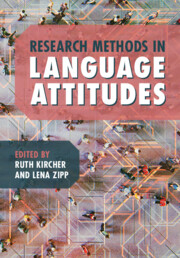Book contents
- Research Methods in Language Attitudes
- Research Methods in Language Attitudes
- Copyright page
- Contents
- Figures
- Tables
- Contributors
- Foreword
- Acknowledgements
- 1 An Introduction to Language Attitudes Research
- Part 1 Analysis of the Societal Treatment of Language
- Part 2 Direct Methods of Attitude Elicitation
- 7 Semi-Structured Interviews
- 8 Focus Groups
- 9 Questionnaires to Elicit Quantitative Data
- 10 Questionnaires to Elicit Qualitative Data
- 11 Perceptual Dialectology
- Part 3 Indirect Methods of Attitude Elicitation
- Part 4 Overarching Issues in Language Attitudes Research
- References
- Index
- References
7 - Semi-Structured Interviews
from Part 2 - Direct Methods of Attitude Elicitation
Published online by Cambridge University Press: 25 June 2022
- Research Methods in Language Attitudes
- Research Methods in Language Attitudes
- Copyright page
- Contents
- Figures
- Tables
- Contributors
- Foreword
- Acknowledgements
- 1 An Introduction to Language Attitudes Research
- Part 1 Analysis of the Societal Treatment of Language
- Part 2 Direct Methods of Attitude Elicitation
- 7 Semi-Structured Interviews
- 8 Focus Groups
- 9 Questionnaires to Elicit Quantitative Data
- 10 Questionnaires to Elicit Qualitative Data
- 11 Perceptual Dialectology
- Part 3 Indirect Methods of Attitude Elicitation
- Part 4 Overarching Issues in Language Attitudes Research
- References
- Index
- References
Summary
This chapter shows how semi-structured interviews can contribute to the study of language attitudes. It pays particular attention to how understanding interviews as contextually and socially situated speech events, shaped by the spatial and temporal context in which they take place and the relationship between interviewer(s) and interviewee(s), is crucial for the analysis and interpretation of interview data. It addresses the strengths of using interviews to investigate attitudes (e.g. that they may bring to light new information, new topics, and new dimensions to established knowledge) as well as their limitations (e.g. that participants may say what they believe the interviewer wants to hear or agree with the interviewer’s questions, regardless of their content). Following a discussion of the key practical issues of planning and research design including constructing an interview protocol, choosing the language or variety to use in the interview, and presenting multiple languages or varieties in interview transcripts, it explains how the qualitative data resulting from semi-structured interviews can be analysed thematically. The chapter ends with an illustration of interview methodology on the basis of a case study of attitudes towards Cypriot Greek in London’s Greek Cypriot diaspora.
Keywords
- Type
- Chapter
- Information
- Research Methods in Language Attitudes , pp. 99 - 113Publisher: Cambridge University PressPrint publication year: 2022
References
Suggested further readings
- 16
- Cited by

